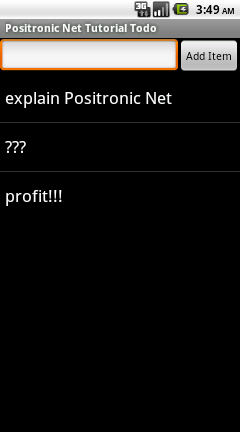Positronic Net Tutorial

Positronic Net is a library that aims to make it more convenient to write Android applications, by taking care of background plumbing tasks, and letting you concentrate less on the requirements of the framework, and more on the problem that you’re trying to solve. To help with that, it’s for applications written in Scala, a JVM-based language that adds type inference and other facilities from functional programming languages. (For the moment, we’re assuming familiarity with both Scala and the basics of the Android API; hopefully, that’ll change at some point.)
This tutorial tries to get you acquainted with the basic concepts of the library, with the simple todo-list application you can see at right. (The initial UI is that users fill in a text field and push an “Add” button to add an item to the list, and tap on the item to remove it. Which is pretty crude; we’ll do better later.)
The payoff is here — an application in which the entire UI code is reduced to this:
class TodoItemsActivity
extends Activity with PositronicActivityHelpers with TypedViewHolder
{
onCreate {
setContentView( R.layout.todo_items )
useAppFacility( TodoDb )
val adapter =
new IndexedSeqSourceAdapter(
this, TodoItem,
itemViewResourceId = android.R.layout.simple_list_item_1 )
findView( TR.listItemsView ).setAdapter( adapter )
findView( TR.listItemsView ).onItemClick{ (view, posn, id) =>
TodoItem ! Delete( adapter.getItem( posn ))
}
findView( TR.addButton ).onClick { addItem }
findView( TR.newItemText ).onKey( KeyEvent.KEYCODE_ENTER ){ addItem }
def addItem = {
val text = findView( TR.newItemText ).getText.toString.trim
if (text != "") {
TodoItem ! Save( new TodoItem( text ))
findView( TR.newItemText ).setText( "" )
}
}
}
}
For this first version, we’ll start by presenting the backing database support which is necessary to support this (which is even shorter than the UI code — 21 lines). Then we’ll show a first version of the UI code, which explicitly does a lot of the plumbing chores which are oddly absent from the sample above: updating the ListView when the list of items changes, closing the database when the Activity shuts down and so forth. Then we’ll go though and see how the library can take care of that plumbing for us.
Broken down into individual sections, that’s as follows, if you’d like to skip ahead — or, just start at the beginning:
-
Basic Setup
Downloading and installing the library and related tooling.
-
Database basics
How to set up data storage for a simple list in less than two dozen lines of code
-
Using the ORM in a simple UI
Database usage, using familiar APIs
-
Tightening things up
Letting the framework take care of some plumbing (and shrinking the UI code by half).
